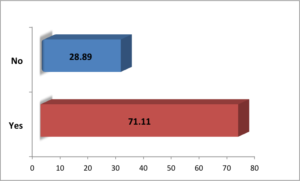The Good, the Bad and the Ugly | Lab Monitoring Survey Results

People love surveys, and we’re no exception. After all, data from a pool of respondents on an interesting topic lets you pattern match to see if your profile matches your cohort. So, being the curious types that we are, Elemental Machines conducted a survey of lab managers and other science professionals to:
- Learn more about their experiences and monitoring priorities,
- Understand how they think about strategic uses of the data, and
- Know what they do with the data and where they store it.
Here’s what we found.
The Findings
First, most people can relate to the issue of lab losses -- sadly. From our data, 71% of respondents have experienced catastrophic equipment failure that resulted in loss of critical samples or materials. To the survey takers and others who’ve shared that experience, we’re terribly sorry. Truly.
 71% of survey respondents have experienced catastrophic equipment failures that have resulted in loss of critical samples or materials.
71% of survey respondents have experienced catastrophic equipment failures that have resulted in loss of critical samples or materials.
Counterintuitively, only 25% monitor all of their equipment, while 64% monitor some pieces of equipment. We found that fascinating since we’re always trying to figure out how people choose which equipment to monitor (value of contents, frequency of use, for example). As for the equipment monitored most frequently, there aren’t really any surprises -- refrigerators and freezers held the lead at 90%, with incubators in second place at 51%, followed by cold rooms (30%), and ovens (10%).
On the topic of what people do with the data, we were fascinated, given the above! Most review and analyze equipment data (71% say yes, 29% say no). And, of those who use the data (these don’t add up to 100%, by the way since participants were allowed to select multiple options), 59% use it to improve operations, 56% use it to optimize equipment performance, while 67% use it to manage maintenance schedules. All good uses for the data, for sure.
The Scary Part?
First, thank you to respondents for their candor. Based on the answers provided, we are confident that responses are accurate. Scarily accurate, in fact. To the question, “Where do you store the data?” answers were distributed across a broad spectrum. They ranged from hard drive to thumb drive to cloud to paper notebook, and everything in between. Some store data electronically (server, USB drive) and others store it in a notebook or binder, while others have a hybrid approach of printing and storing in the cloud.
This is the state of the state in most every laboratory, and the issue isn’t limited to monitoring data. These answers likely apply to all types of data, and reveal the reality about data-management strategies in laboratory environments: many teams do not have a consistent and integrated approach to managing, storing and using data. They also have gaps in the data they access and use, all of which hamper their work.
Moving to a Data-First Approach
Moving towards an integrated, data-first approach has the potential to transform science-based industries, just as data-driven strategies have been used to optimize manufacturing of numerous types of products, from automotive to pharma. We see ample evidence that the various science-based industries -- from pharma to synthetic biology to agro science -- are moving in this direction, but the challenge is where to start since the problem is vast and the range of possible solutions can be overwhelming.
While we don’t purport to have all of the answers, we do have some recommendations. They are outlined more comprehensively in our white paper, The Smart Lab, the IoT and the Data-Driven Lab Manager, which we encourage you to download. It’s a framework for thinking about the issue. We also encourage you to think about your long-term goals and make short-term decisions that align with those goals. For example, if you’re considering a monitoring solution -- either for the first time, or to replace a legacy system -- make sure one of your key evaluation criteria is seamless data exchange between your monitoring system and other systems of record. Any system that puts the burden on staff to manually move data from one system to another isn’t helping move forward.
Monitoring | A Springboard into the Smart Lab
While the data show that monitoring is widespread, it’s time to begin thinking of monitoring as a pathway to the Smart Lab, rather than a goal unto itself. With that view, teams begin to think about the data provided by the monitoring system and how they can use that data to accelerate their work. And that is our mission -- to provide data-driven insights from the physical world to accelerate R&D and optimize manufacturing.
Note: This post is also published on Medium here.
Never miss a beat...
Subscribe to our bi-monthly EM Connect Newsletter to stay up-to-date on all things LabOps, biotech, and more!